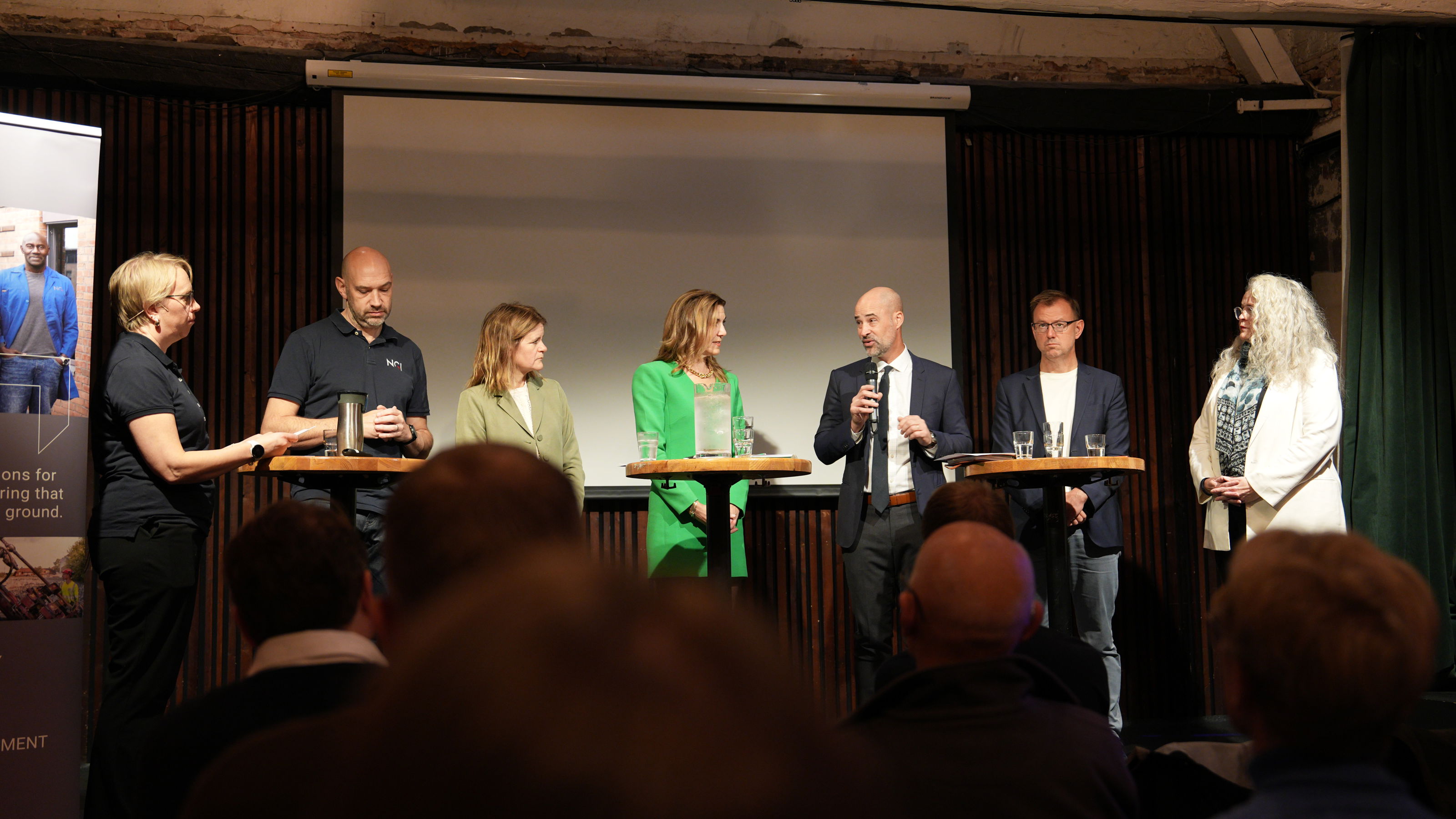Predictability is the Key to Success in Offshore Wind
Without stable frameworks, offshore wind development grinds to a halt. That was the main message when NGI and NIVA gathered researchers, industry leaders, and politicians for a breakfast seminar at Kulturhuset in Oslo.

Researchers and representatives from the offshore wind industry participated in the panel at the breakfast seminar “Offshore Wind: Waste or Solution?” at Kulturhuset in Oslo, organized by NGI and NIVA. From left: Øydis U. Castberg (moderator), Thomas Langford (NGI), Kristin Nergaard Berg (DNV), Thina Margrethe Saltvedt (Nordea), Stephen Bull (Vårgrønn), Jon Evang (Renewable Norway), and Solrun Figenschau Skjellum (NIVA). ( Photo: Ruben Anda / NIVA)
At the seminar, we discussed the need for closer cooperation between research, industry, and politics to accelerate the offshore wind transition. Without stable frameworks for investment, spatial planning, and environmental considerations, development comes to a standstill – regardless of technology or ambition.
“The framework conditions for this industry change frequently, from taxation to access to areas. That makes it challenging to calculate profitability and plan for the long term”, said Thina Margrethe Saltvedt, Chief Analyst in the Global Sustainability division at Nordea.
Stable Rules of the Game
Both industry representatives and environmental voices agreed: predictable processes are essential for building a new offshore wind industry.
Jon Evang, Director for Offshore Wind at Renewable Norway, said, "We need a system where licensing rounds and processes happen regularly and according to a set plan, just like the oil and gas industry has had. That enables businesses and authorities to plan."
Stephen Bull, CEO of Vårgrønn, added that stable conditions were crucial for the profitability of the oil industry:
– Oil and gas have continuously operated within fixed frameworks. That’s one of the reasons the industry became so profitable, he said.
Knowledge as the Foundation
Thomas Langford, Director for Offshore Energy at NGI, emphasized that technology development, standardization, and industrial experience are key to profitable and safe scaling.
“To succeed, we must be able to build, transport, and install far more foundations than we do today. Profitability lies in technology, standardization, and industrial scaling”, Langford said.
He reminded the audience that research and industry must move hand in hand:
– NGI’s role is to provide knowledge that reduces risk in offshore developments. That means understanding the seabed better, ensuring safe foundations, and finding sustainable solutions.
Solrun Figenschau Skjellum, Director of Development at NIVA, highlighted the need to strengthen the environmental knowledge base, especially for floating wind:
“Developers need access to detailed environmental data early in the planning phase. If the data comes too late, design changes become too costly”, she said.
She also pointed out that uncertainty in the industry spills over into research – fewer projects receive funding when the framework conditions are unclear.

Mani Hussaini from the Labour Party and Kari Sofie Bjørnsen from the Conservative Party, both members of the Norwegian Parliament’s Standing Committee on Energy and the Environment. They strongly support offshore wind but emphasized that long-term commitment requires broad, cross-party agreements that stand the test of time. ( Photo: Ruben Anda / NIVA)
Political Will – and the Need for Long-Term Consensus
In the political part of the seminar, Mani Hussaini (Labour Party, Chair of the Standing Committee on Energy and the Environment) and Kari Sofie Bjørnsen (Conservative Party, Committee Member) agreed on one thing: offshore wind must be lifted out of election cycles and into long-term national planning.
“Offshore wind is a “kinder egg” for Norway: more power, lower emissions, and new jobs. But stable frameworks can’t be renegotiated every election”, said Hussaini.
Bjørnsen from the Conservative Party followed up:
“We must learn from the land-based energy conflicts and build a plan that lasts. We can’t keep changing course with every new government”, she said.
Research, Policy, and Industry – Moving in Sync
It’s easy to think offshore wind isn’t profitable. And for significant new projects on the Norwegian shelf, that’s true. Development in deep and challenging waters requires state support and stable frameworks. But the bigger picture is more complex. Norway already has a profitable supplier industry that delivers technology, services, and equipment to offshore wind projects worldwide. This export is worth 44–50 billion NOK annually and employs over 6,000 people. Every third offshore wind turbine installed globally has been delivered or installed by Norwegian companies.
“We already have a profitable export industry in offshore wind. The question is whether we’ll build a home market that allows us to grow further”, said Evang from Renewable Norway.
The seminar revealed a clear shared responsibility: Norway can build a profitable and sustainable offshore wind industry – but research, politics, and industry must move in sync over time.
“We must ensure that knowledge enters the process early enough. That way, offshore wind can be developed on nature’s terms – and become a new industrial strength for Norway”, said Skjellum from NIVA.